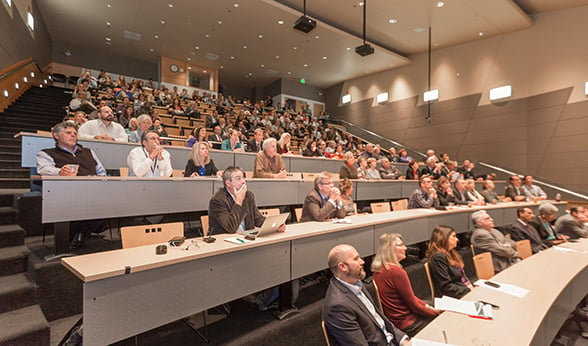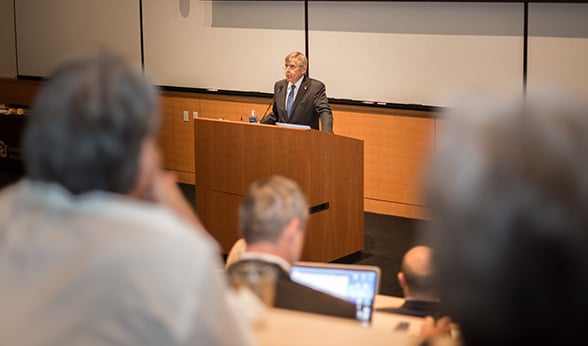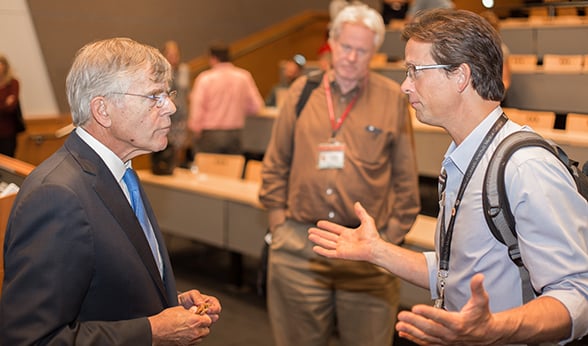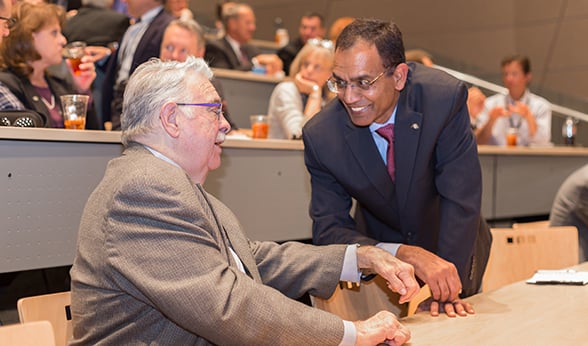In his “State of the Campus” address, Chancellor Don Elliman challenged CU Anschutz Medical Campus leaders to think big and be nimble, to both create another leading “headline” healthcare service as well as “continue to reinvent ourselves” amid a changing marketplace. He emphasized that now is the time to build on unprecedented momentum in the campus’s tri-fold mission of healthcare education, clinical care and research.
Elliman delivered his remarks to an audience in Hensel-Phelps West Auditorium on Tuesday. His presentation touched on where CU Anschutz has been – just Building 500 and some barren ground not many years ago – to where it is now – a thriving academic medical center of over 4,000 students, some 2 million patient visits and a research portfolio of over $420 million each year. He laid out a vision of where the campus should go, distilling the strategies into a singular ambition: “We are very good; we seek to be the best.”
 A full house in the Hensel-Phelps West Auditorium attended Chancellor Elliman's State of the Campus address on Nov. 1.
A full house in the Hensel-Phelps West Auditorium attended Chancellor Elliman's State of the Campus address on Nov. 1.
Elliman’s roadmap for reaching that pinnacle includes nine potential strategies, which were developed through conversations with faculty and staff. After explaining the plan’s elements, he said, “Now it’s your turn,” inviting the campus community to offer feedback. The complete “State of the Campus” text can be found at www.ucdenver.edu/AnschutzStrategies, which includes a link for posting ideas and suggestions.
‘Our next horizons’
After detailing CU Anschutz’s momentum over just the past two years – including the School of Medicine’s (SOM) $80 million investment in five new transformational research projects; unprecedented efforts to build the faculty base in quality and quantity; national rankings of both clinical affiliates, UCHealth and Children’s Hospital Colorado; new leadership at both hospitals on campus and at the SOM; and major financial backing to develop the Colorado Center for Personalized Medicine and the data warehouse COMPASS – the chancellor posed the question: “So where do we look for our next horizons?”
 CU Anschutz Chancellor Don Elliman delivers his State of the Campus address on Nov. 1.
CU Anschutz Chancellor Don Elliman delivers his State of the Campus address on Nov. 1.
New horizons, both aspirational and marketplace-oriented, are necessary because the landscape is shifting, he said. Most analysts expect a consolidation in research funding in upcoming years, meaning fewer academic medical centers are likely to be serious players. CU Anschutz must be one of those players, Elliman said, both in terms of basic and translational science.
‘Finest care in the world’
“We seek to be a medical destination of such breadth and quality,” he said, “that no one from the Rocky Mountain region should ever have to travel beyond this campus to receive the finest care in the world.”
Elliman noted that clinical revenues for both faculty and affiliates will be impacted by a changing environment for reimbursement rates and policies. Likewise, the future of federal research funding is unpredictable, and we live in a highly competitive clinical environment.
https://www.youtube.com/watch?v=TpWSEuvP8X4
On the plus side, he said, CU Anschutz is in a fast-growing market and enjoys the distinction of being the only academic medical center over a very wide geographic territory. CU Anschutz is also extremely robust in that it is one of very few academic medical centers in the nation with all five major health science schools and colleges on a contiguous campus. Overall, he said, “we face a fluid future, but with at least as much potential for wind in our face as we have out our backs.”
Nine potential strategies
With that, Elliman unfurled nine suggested strategies for the campus:
- Invest in becoming a “top 5” in a major service line. CU Anschutz is already there with Pulmonology – a shared distinction with National Jewish. “This isn’t to suggest we ignore the pursuit of excellence in other areas; it is to say we need another ‘headline.’” He said the SOM’s transformational research grants provide a leg up to specific areas of research in this process, and it’s critical that both affiliate clinical partners agree on the selection.
- Move from the mid-20s in ranking for NIH research funding to the mid-teens, headed to the top 10. “Our role in helping to redefine the future of healthcare is at the core of who we are and represents our single biggest brand differentiator … Again, the transformational research grants should provide significant seed funding.”
- Diversify our research portfolio. The campus has made recent strides – including a revamping of tech transfer into CU Anschutz Innovations and a more customer-focused Grants and Contracts organization – but more can be done to grow support for internal entrepreneurship and infrastructure, as well as accelerate connections to industry. On the big-data front, CU Anschutz has created data resources with the Colorado Center for Personalized Medicine and COMPASS. But the major players in healthcare data are the Googles, Amazons, Apples and the like, Elliman said. “We have to think about how we interface with that reality.”
- Go big in mental health, which the chancellor calls the most unmet need in American healthcare. CU Anschutz has expanded its footprint here – notably with the creation of the National Behavioral Health Innovation Center and the expansion of the Helen and Arthur E. Johnson Depression Center – but the efforts have tended to be independent of one another. “We need to bring them together into a common strategy,” he said, “and we need to match our clinical expansion with renewed emphasis on research and education.”
- Expand our ability and capacity to train the healthcare workforce. The campus needs to expand educational opportunities and output for physician assistants, advanced practice nurses and mental health professionals, to name a few. Funding will be a challenge, he said, “but if our workforce provider role in the region is to be fulfilled, we need to find a way.”
- Tell the world who we are and what we do. The campus remains an unknown entity to too many residents in Colorado, the Rocky Mountain region and globally, the chancellor said. “We have a wonderful story to tell, and it gets better every day.”
- Take more advantage of our co-location on campus. More than ever, healthcare is becoming a “team sport.” Elliman said that CU Anschutz, with its five health-related schools and major hospital affiliates, should better leverage this proximity to build more bridges between faculties, and create more multidisciplinary teams in research and education.
- Become more risk-tolerant. Obviously, we should not take risks with regard to patient care, government compliance and other critical areas. Rather, “we have to get comfortable in dialing up our willingness to take calculated chances” that will help the campus grow in expertise and prestige, he said. The transformational research grants and a proposed new building on CU Anschutz’s horizon are examples of bets that will provide even greater returns to the campus.
- Set priorities and allocate resources accordingly. No matter how the plans turn out, he said, campus leaders must be ready to make difficult choices to focus resources on top priorities.
Expand revenues, clinical footprints
Elliman said the rate of progress on these objectives will depend on critical factors. They include clinical revenue growth, fostering and improving relations with hospital affiliates, embracing technology, campus infrastructure, space, talent and philanthropic growth (which has more than doubled from just five years ago).
 Chancellor Don Elliman chats with Patrick Gaines, executive director of the Gates Center for Regenerative Medicine, after the State of the Campus address on Nov. 1.
Chancellor Don Elliman chats with Patrick Gaines, executive director of the Gates Center for Regenerative Medicine, after the State of the Campus address on Nov. 1.
The chancellor said the SOM has seen its clinical revenues grow at over 10 percent a year for more than a decade. “We need to do everything we can to continue that trend … Further, I’d suggest all our other schools, many of which already have a clinical presence, need to look for ways to expand their clinical footprint.”
With regard to space, he said, the campus desperately needs another building to meet existing demands for clinical, laboratory and office space. Elliman expects that after construction of the next building – which could be 300,000 to 400,000 square feet in size, with a groundbreaking next year – the campus will need to plan the next one.
On the subject of talent, Elliman quoted former Apple CEO Steve Jobs: “Hiring the best is our most important task.” The chancellor said, “Our faculty – your talent – make this place what it is. If the talent base is getting better, we will get better with it.”
‘An amazing place’
He concluded by saying “this is an amazing place; together, we can make it even better” and reiterating that campus leadership will use plan feedback to guide the next steps.
 Richard Traystman, vice chancellor for research, chats with Ravinder Singh, chair of the CU Faculty Council, before the State of the Campus address.
Richard Traystman, vice chancellor for research, chats with Ravinder Singh, chair of the CU Faculty Council, before the State of the Campus address.
A question was asked about the CU Cancer Center. If only 14 percent of people in Colorado with cancer come to the Cancer Center for treatment, an audience member asked, where do the remainder of patients go and what would happen if “suddenly they all decided to come here?”
The chancellor acknowledged that it would be a challenge if all of those patients currently going elsewhere came to our Cancer Center for treatment. But in general, the Cancer Center – one of only 47 NIH/NCI-designated comprehensive cancer centers in the U.S. – has the capacity to treat many more Colorado-based patients, he said.
Elliman added that campus leadership is close to finalizing a branding platform specifically for CU Anschutz, a task complicated because the affiliated hospitals on campus have individual brands that also need to be recognized.
“We’ve never done a particularly aggressive job at telling people what we have on this campus. That’s got to change, and the Cancer Center is one example,” Elliman said. “We have phenomenal resources in this very, very broad group of skill sets and we don’t get enough recognition for the work we do.”
